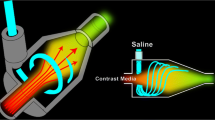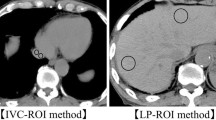Abstract
Objective
To evaluate the effect of a newly developed connecting tube, which generates a spiral flow of saline, on aortic and hepatic contrast enhancement during hepatic-arterial phase (HAP) and portal venous phase (PVP) computed tomography (CT).
Methods
Eighty patients were randomly assigned to one of two protocols: with a new or a conventional tube. The contrast material (600 mgI/kg) was delivered over 30 s; this was followed by the administration of 25 ml saline solution delivered at the same injection rate as the contrast material. Unenhanced and contrast-enhanced CT images of the upper abdomen were obtained. We calculated the changes in the CT number (∆HU) for the aorta during HAP and PVP, and for the liver during PVP. We compared ∆HU between protocols.
Results
The mean ∆HU for the abdominal aorta during HAP was significantly higher with the new tube protocol than with the conventional tube protocol (322 ± 53 vs. 290 ± 53, P < 0.01). There were no significant differences in the mean ∆HU for the abdominal aorta and liver during PVP between the two protocols (P > 0.05).
Conclusion
The new connecting tube increased the effect of a saline chaser and significantly improved aortic enhancement during HAP.
Key Points
• Optimal administration of intravenous contrast material is essential for optimal CT quality.
• A new connecting tube can generate spiral flow, which improves intravenous administration.
• The new connecting tube improved aortic contrast enhancement during the hepatic-arterial phase.
• The new connecting tube increased the effect of a saline chaser.




Similar content being viewed by others
References
Kim DJ, Kim TH, Kim SJ et al (2008) Saline flush effect for enhancement of aorta and coronary arteries at multidetector CT coronary angiography. Radiology 246:110–115
Schoellnast H, Tillich M, Deutschmann HA et al (2004) Improvement of parenchymal and vascular enhancement using saline flush and power injection for multiple-detector-row abdominal CT. Eur Radiol 14:659–664
Schoellnast H, Tillich M, Deutschmann MJ, Deutschmann HA, Schaffler GJ, Portugaller HR (2004) Aortoiliac enhancement during computed tomography angiography with reduced contrast material dose and saline solution flush: influence on magnitude and uniformity of the contrast column. Invest Radiol 39:20–26
Haage P, Schmitz-Rode T, Hubner D, Piroth W, Gunther RW (2000) Reduction of contrast material dose and artifacts by a saline flush using a double power injector in helical CT of the thorax. AJR Am J Roentgenol 174:1049–1053
Irie T, Kajitani M, Yamaguchi M, Itai Y (2002) Contrast-enhanced CT with saline flush technique using two automated injectors: how much contrast medium does it save? J Comput Assist Tomogr 26:287–291
Behrendt FF, Bruners P, Keil S et al (2010) Effect of different saline chaser volumes and flow rates on intravascular contrast enhancement in CT using a circulation phantom. Eur J Radiol 73:688–693
Lee K, Kishimoto M, Shimizu J, Iwasaki T, Miyake Y, Yamada K (2010) Effect of a saline chaser for contrast enhancement of computed tomographic angiography in cattle. Vet Rec 166:137–139
Yoon DY, You SY, Choi CS et al (2006) Multi-detector row CT of the head and neck: comparison of different volumes of contrast material with and without a saline chaser. Neuroradiology 48:935–942
de Monye C, Cademartiri F, de Weert TT, Siepman DA, Dippel DW, van Der Lugt A (2005) Sixteen-detector row CT angiography of carotid arteries: comparison of different volumes of contrast material with and without a bolus chaser. Radiology 237:555–562
Behrendt FF, Jost G, Pietsch H et al (2011) Computed tomography angiography: the effect of different chaser flow rates, volumes, and fluids on contrast enhancement. Invest Radiol 46:271–276
Schindera ST, Nelson RC, Howle L, Nichols E, DeLong DM, Merkle EM (2008) Effect of varying injection rates of a saline chaser on aortic enhancement in CT angiography: phantom study. Eur Radiol 18:1683–1689
Marin D, Nelson RC, Guerrisi A et al (2011) 64-section multidetector CT of the upper abdomen: optimization of a saline chaser injection protocol for improved vascular and parenchymal contrast enhancement. Eur Radiol 21:1938–1947
Lee CH, Goo JM, Bae KT et al (2007) CTA contrast enhancement of the aorta and pulmonary artery: the effect of saline chase injected at two different rates in a canine experimental model. Invest Radiol 42:486–490
Li H, Tomita Y (1998) An experimental study of swirling flow pneumatic conveying system in a vertical pipeline. J Fluid Eng 120:200–203
Li H, Tomita Y (1996) An experimental study of swirling flow pneumatic conveying system in a horizontal pipeline. J Fluid Eng 118:526–530
Awai K, Hatcho A, Nakayama Y et al (2006) Simulation of aortic peak enhancement on MDCT using a contrast material flow phantom: feasibility study. AJR Am J Roentgenol 186:379–385
Awai K, Hiraishi K, Hori S (2004) Effect of contrast material injection duration and rate on aortic peak time and peak enhancement at dynamic CT involving injection protocol with dose tailored to patient weight. Radiology 230:142–150
Bae KT. Intravenous contrast medium administration and scan timing at CT: considerations and approaches. Radiology 256:32–61
Acknowledgements
There was no direct financial support from industry for this study. This study received the connecting tube from Nemoto-Kyorindo, Tokyo, Japan, the manufacturer of the connecting tube used in this study. K.Y. is an employee of Nemoto-Kyorindo. Y.P. is chief executive officer of EBM, Tokyo, Japan. Y.P. and T.Y have pending and/or awarded patents for the subject matter described in the manuscript and receive royalty income for a patent license from Nemoto-Kyorindo. The authors (M.K, T.N, K.A, T.K, K.H, Y.Y) who were not employees of Nemoto-Kyorindo or EBM had control of data and information that might have presented a conflict of interest.
Author information
Authors and Affiliations
Corresponding author
Electronic supplementary material
Below is the link to the electronic supplementary material.
An image obtained by actually imaging the pushed state of the contrast agent using the new connecting tube. A black ink was mixed to the contrast agent. The saline flow rate was 4 ml/s. The pushed state was imaged by 500 frames per second using a high-speed camera. The portion appearing black in Movie 1 was the flow of the contrast agent. As understood from Movie 1, the new connecting tube was able to generate the spiral flow (MPG 2948 kb)
Rights and permissions
About this article
Cite this article
Kidoh, M., Nakaura, T., Awai, K. et al. Novel connecting tube for saline chaser in contrast-enhanced CT: the effect of spiral flow of saline on contrast enhancement. Eur Radiol 23, 3213–3218 (2013). https://doi.org/10.1007/s00330-013-2923-x
Received:
Accepted:
Published:
Issue Date:
DOI: https://doi.org/10.1007/s00330-013-2923-x




